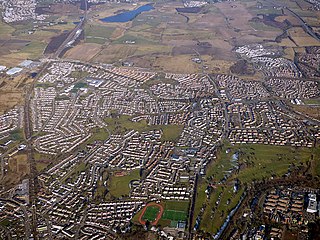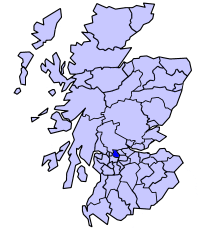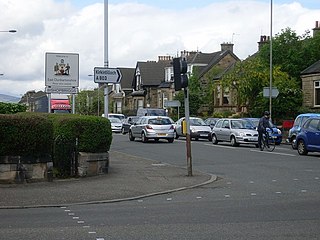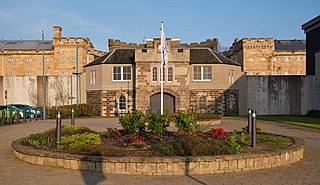
East Dunbartonshire is one of the 32 council areas of Scotland. It borders the north of Glasgow and contains many of the affluent areas to the north of the city, including Bearsden, Milngavie, Milton of Campsie, Balmore and Torrance, as well as many of the city's commuter towns and villages. East Dunbartonshire also shares borders with North Lanarkshire, Stirling and West Dunbartonshire. The council area covers parts of the historic counties of Dunbartonshire, Lanarkshire and Stirlingshire.

Bishopbriggs is a town in East Dunbartonshire, Scotland. It lies on the northern fringe of Greater Glasgow, approximately 4 miles (6 km) from the city centre. Historically in Lanarkshire, the area was once part of the historic parish of Cadder - originally lands granted by King William the Lion to the Bishop of Glasgow, Jocelin, in 1180. It was later part of the county of Lanarkshire, and then an independent burgh from 1964 to 1975. Today, Bishopbriggs' close geographic proximity to Glasgow now effectively makes it a suburb and commuter town of the city. The town's original Gaelic name Coille Dobhair reflects the name of the old parish of Cadder, but modern Gaelic usage uses Drochaid an Easbaig, a literal translation of Bishopbriggs. It was ranked the 2nd most desirable postcode in Scotland to live in following a study by the Centre for Economic and Business Research in 2015 and 2016.

Strathkelvin is the strath (valley) of the River Kelvin in west central Scotland, lying north-east of Glasgow. The name Strathkelvin was used between 1975 and 1996 for one of nineteen local government districts in the Strathclyde region.

Cumbernauld, Kilsyth and Kirkintilloch East is a constituency of the House of Commons of the Parliament of the United Kingdom. It was created for the 2005 general election, replacing Cumbernauld and Kilsyth and part of Strathkelvin and Bearsden.
HM Prison Lindholme is a Category C/D men's prison located near Hatfield Woodhouse in the Metropolitan Borough of Doncaster, South Yorkshire, England. Lindholme is operated by His Majesty's Prison Service, and is situated in close proximity to Hatfield and Moorland prisons

Lenzie is an affluent town by the Edinburgh and Glasgow Railway in the East Dunbartonshire council area of Scotland. It is about 6 miles (10 km) north-east of Glasgow city centre and 1 mile (2 km) south of Kirkintilloch. At the 2011 census, it had a population of 8,873. The ancient barony of Lenzie was held by William de Comyn, Baron of Lenzie and Lord of Cumbernauld in the 12th century.

Cadder is a district of the town of Bishopbriggs, East Dunbartonshire, Scotland. It is located 7 km north of Glasgow city centre, 0.5 km south of the River Kelvin, and approximately 1.5 km north-east of Bishopbriggs town centre, sited on the route of the Forth and Clyde Canal. There is a Glasgow council housing scheme of a similar name, generally pronounced Cawder, in the district of Lambhill some 3 miles (5 km) to the south-west along the Canal, which was built in the early 1950s. Similarly, within Cadder, there is Cawder Golf Club, which also uses that original pronunciation.

Colston is a mostly residential area in the Scottish city of Glasgow; situated on the northern edge of the city, it is surrounded by the Glasgow areas of Milton to the west and Springburn to the east, and the town of Bishopbriggs to the north. The main road through Colston is the A803, which then becomes Kirkintilloch Road once past Colston to the north through Bishopbriggs.

Bishopbriggs railway station is a railway station serving Bishopbriggs in East Dunbartonshire, Scotland. It is located on the Glasgow to Edinburgh via Falkirk Line, 3+1⁄4 miles (5.2 km) north of Glasgow Queen Street, but is currently only served by services on the Croy Line.

Torrance is a relatively affluent village in East Dunbartonshire, formerly Stirlingshire, Scotland, located eight miles north of Glasgow city centre. Torrance used to mainly consist of farmland. The village was once famous as a resting place for workers on their way to the Campsie Fells four miles north. The Forth and Clyde Canal has a wharf nearby at Hungryside, and the A807 runs along its southern edge. The village has an active community charity whose aims are to improve the village facilities.

The Scottish Prison Service (SPS) is an executive agency of the Scottish Government tasked with managing prisons and Young Offender Institutions.

HM Prison Barlinnie is the largest prison in Scotland. It is operated by the Scottish Prison Service and is located in the residential suburb of Riddrie, in the north east of Glasgow, Scotland. It is informally known locally as The Big Hoose, Bar and Bar-L. In 2018, plans for its closure were announced.
Turnbull High School is a co-educational comprehensive secondary school located in Bishopbriggs, East Dunbartonshire, Scotland. The school was named after William Turnbull, Bishop of Glasgow from 1448 to 1454, and founder of the University of Glasgow in 1451, of which he was the first Chancellor. Whilst enrollment is open to pupils of all religious denominations and none, the School's religious ethos emphasises practice of Roman Catholic moral values both in the church and in the community, with its own Chaplain and many associated charitable and community-based activities undertaken.

Bishopbriggs Academy is a secondary school in the town of Bishopbriggs, Scotland, in the district of East Dunbartonshire. Bishopbriggs Academy is a non-denominational, co-educational, comprehensive school taking pupils from S1 to S6. It is currently one of two secondary schools in Bishopbriggs, along with Turnbull High School at Brackenbrae.

HM Prison Perth is a prison that houses short term adult male prisoners. A maximum security establishment which also houses fine defaulters and those on remand from the courts of Angus, City of Dundee, Perth and Kinross and the northern part of Fife. There is also a secure unit for Category A prisoners who are serving sentences of up to life imprisonment. It is Scotland's oldest prison still in use.

Kirkintilloch Town Hall is a municipal building in Union Street in Kirkintilloch, East Dunbartonshire, Scotland. It is a category B listed building.

HMP & YOI Grampian is a high security prison in Peterhead, Scotland. It is the only such facility in the northeast of the country, having replaced the former HMPs in Aberdeen and Peterhead in 2014. It is the newest jail in Scotland and amongst the newest in the United Kingdom. It has a design capacity of around 560 inmates.
Prison: First & Last 24 Hours is a British documentary series that was broadcast between 28 October 2015 and 5 December 2016 on Sky 1. It followed prisoners in four Scottish Prison Service-run prisons in Scotland who are either in their first 24 hours of their sentences or are about to be released from jail.
Elections to East Dunbartonshire Council were held on Thursday 4 May, the same day as the 31 other local authorities in Scotland. The election used seven wards created under the Local Governance (Scotland) Act 2004, a reduction of one from 2012, with 22 Councillors being elected, 2 fewer overall. Each ward elected either 3 or 4 members, using the STV electoral system.

Bishopbriggs North and Campsie is one of the seven wards used to elect members of the East Dunbartonshire Council. It elects four Councillors.




















